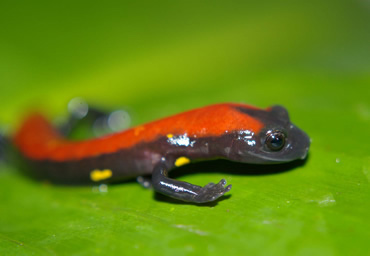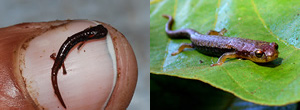Three salamander species discovered in Costa Rica
Three salamander species discovered in Costa Rica
Jeremy Hance, mongabay.com
January 6, 2008
Scientists from the Natural History Museum of London have discovered three new species of salamander in south-eastern Costa Rica. This brings the nation’s total to forty-three species, meaning that this small tropical nation contains approximately nine percent of the world’s salamanders.
Two of the newly-discovered species are nocturnal and in the Bolitoglossa genus. The largest of these is uniquely colored: a bright red back contrasted against a black body with small spots of yellow appearing on its flanks. The other is brown with a pale underside. The third species is a dwarf salamander—a member of the Nototriton genus—and is no larger than a quarter. None of the three species have been named: the University of Costa Rica will have that honor.
 Brightly colored, this new salamander species is one of 3 discovered in an unexplored forest in Costa Rica © A Monro |
Dr. Alex Monro, who led the expedition, says that “finding so many new species in one area is exciting. Particularly as this is probably the only place in the world you can find these animals”. The three new salamanders were found in the largest reserve in Central America, La Amistad National Park. The park lies mostly in Costa Rica but is co-managed by Costa Rica and Panama. La Amistad National Park is known for its rugged terrain and size, in fact it is one of the most unexplored parks in the region. Nearly a million acres in size, this UNESCO reserve contains a wealth of biodiversity: more than 250 species of reptiles and amphibians, 600 birds, 215 mammals, and an astounding 14,000 species of plants have been recorded. The park also boasts the largest population of jaguars in Central America.

A new species of dwarf salamander: no larger than a quarter (left). One of the new species of salamander in the Bolitoglossa genus. It is nocturnal (right). Images © A Monro |
The finding of these new species comes at an imperative time. Perhaps no animal taxon is more threatened than amphibians. Scientists have stated that without action one-third to a half of amphibians may go extinct. Dr. Monro believes that although “there have been far fewer studies of salamanders than anurians” salamanders are believed to be just as threatened as frogs and toads. The reasons are varied; the number one killer so far seems to be a fungal disease called Chytridiomycosis, but it is believed that global warming, habitat destruction, and pollution have also had a large impact on amphibians. Dr. Monro states that it is reasonable to assume that the three new species are vulnerable to Chytridiomycosis and climate change, adding that “not a lot is known about the decline apart from the potential causes and documenting its progress. I know that the University of Costa Rica in association with US and Panamanian institutions are doing research on this at the moment.” Institutions are reacting as well: zoos, botanical gardens, and aquariums around the world have begun a program called Amphibian Ark to establish captive breeding programs for the world’s 500 most endangered amphibians.
As such institutions are working hard to halt the worldwide decline of amphibians, Dr. Monro and the Natural History Museum of London is engrossed in cataloguing the many species still unknown to science. Added together, these forces will help preserve species that were entirely unknown a year ago. Four more expeditions are planned to La Amistad National Park this year. Dr. Monro says, “who knows what we could find when we go back?”
One thing is certain: we can’t wait to see.







